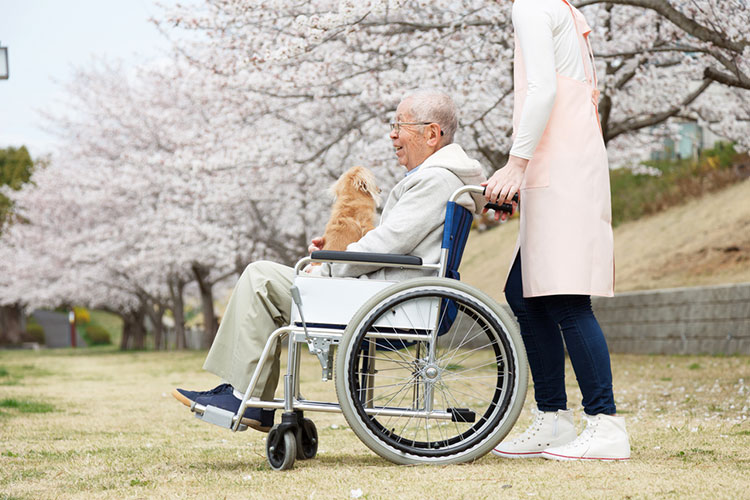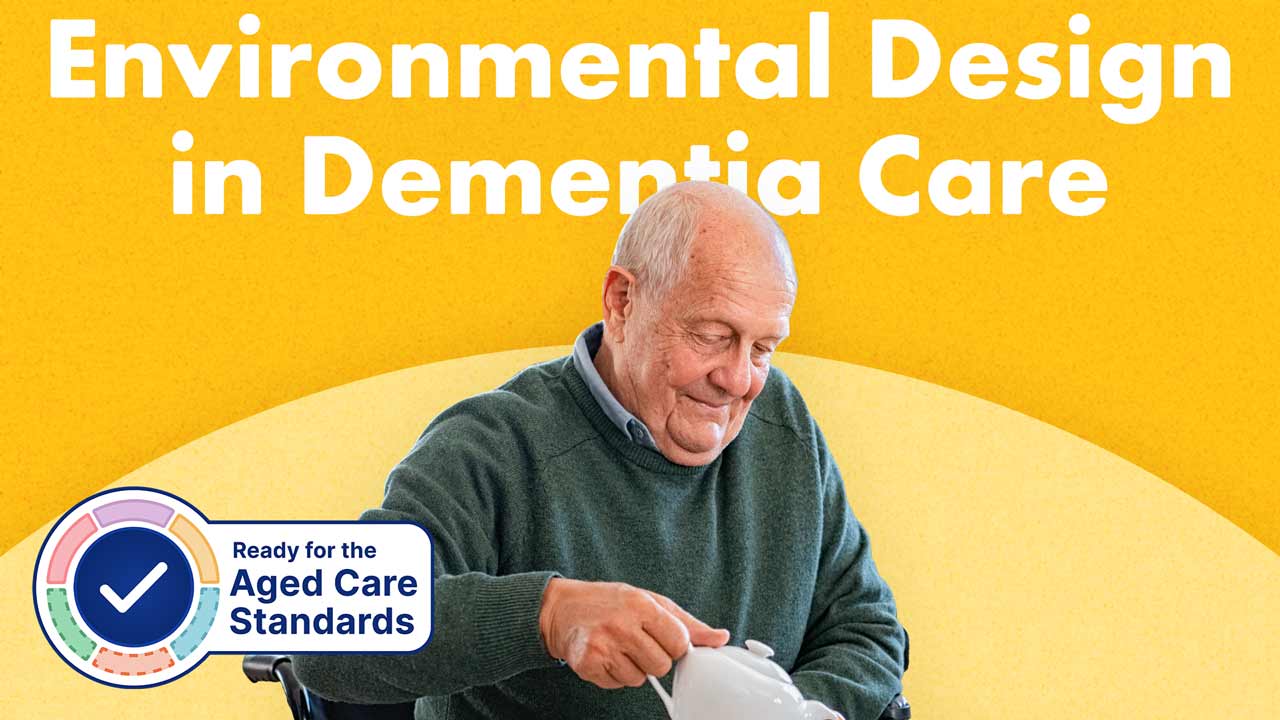A person is only as restricted as their environment causes them to be.
Cognitive capacities are impacted when a person develops dementia. As a result, physical and social environments become increasingly difficult to navigate.
Because of this, care and thought must be applied to the design of environments for people with dementia.
Environmental consideration should be an important factor in the provision of care.
Environmental Design Under the Strengthened Aged Care Quality Standards
Standard 4: The Environment - Outcome 4.1b: Environment and equipment in a service environment under the strengthened Aged Care Quality Standards (Action 4.1.1a) requires aged care service environments to:
- Be clean
- Be well-maintained
- Be safe, welcoming and comfortable
- Be fit-for-purpose
- Be accessible, including for older people living with disability
- Facilitate movement, engagement and inclusion through its design
- Facilitate free movement both inside and outside
- Reduce safety risks without being obtrusive
- Promote useful stimulation
- Be easy to navigate.
(ACQSC 2024)
What is Environmental Design?

In a residential aged care context, environmental design is the ordering of small and large-scale aspects of the environment by means of architecture, engineering, landscape architecture and planning (Collins Dictionary 2024). This article will also address interior design.
Good environmental design can assist a resident in finding their way around, as well as reduce confusion and increase independence.
A design-for-dementia framework requires a change in the way we think about illness. Rather than believing that a person will naturally become more limited as their dementia progresses, we can think about how that person is more limited by their environment than by their illness - put another way, a person is only as restricted as their environment causes them to be.
Environmental Design Modification
Environmental design modification has been shown to reduce agitation and frustration in residents living with dementia (Fleming & Bennet 2021).
When designing for dementia, it’s unwise to choose boring, bland and repetitive environments - in fact, these might prove to be more confusing for residents (Keast 2016).
The key to all design choices is to have every decision guided by the intention to create meaningful and relevant environments for residents.
Examples of design modifications for effective dementia care include:
- Utilisation of natural light
- Colour coding for walls and skirting boards
- Personalised doors for residents to help them identify their rooms
- Visual cues, for example, cues to identify corridors leading to the dining area
- Realistic-looking murals to disguise walls, fences and secure doors.
(IRT 2023)
Effects of a Well-Designed Environment for People with Dementia
A well-designed environment can lead to visible enhancements in:
- Wayfinding
- Eating behaviours
- Motor function
- Mobility
- Toilet usage
- Staff/resident interaction
- Quality of life
- Independence in dressing
- Vitality
- Socialisation between residents.
(Fleming & Bennet 2021)
Six Considerations for Dementia-Friendly Design
1. Familiarity
People are able to recognise and understand their environment, which:
- Prevents and/or ameliorates spatial disorientation
- Aids short-term memory.
2. Legibility
People are able to understand where they are and where they need to go, which prevents and/or alleviates:
- Spatial disorientation
- Confusion
- Anxiety.
3. Distinctiveness
Distinctiveness aids our ability to concentrate and pay attention. Distinctiveness in a neighbourhood encourages:
- Orientation
- Wayfinding.
4. Accessibility
Residents are able to reach, enter, use and move around places or spaces they need to, regardless of physical, sensory or cognitive impairment, which:
- Facilitates movement
- Reduces injury and frustration.
5. Comfort
Residents feel relaxed and able to visit, use and enjoy spaces of their choice, which:
- Reduces physical and/or psychological discomfort.
6. Safety
Residents are allowed to move around, use and enjoy the neighbourhood without fear of harm, which:
- Increases morale
- Decreases risk of injury.
(Fleming & Bennet 2021)

Principles of Dementia-Friendly Design
The six considerations above should be guided by the following six principles, which have been developed by Dementia Training Australia through research and local and international case studies:
Principle 1: Unobtrusively Reduce Risks
Residents require environments that are, above all, easy and safe to move around in if their independence and daily freedom is to be enabled. However, safety measures should blend seamlessly into the environment. Safety features such as gates or fences should be unobtrusive to prevent resident frustration.
Principle 2: Provide a Human Scale
The feelings and behaviours of people with dementia can be greatly affected by the size and scale of a building. Three factors are particularly important here:
- The number of people the person encounters
- The size of the building
- The size of the building’s components.
Considerations are to be made to reduce the risk of a resident being intimidated or confronted by their environment, interactions and number of choices.
Principle 3: Allow People to See and Be Seen
The environment should be easily understood by residents. It is crucial that a resident can recognise where they are, where they’ve come from and where they are going. Residents are more able to make choices about the directions they want to go in when they can easily see key places such as the lounge room, dining room, bedroom, kitchen and outdoors. Visual access is essential to allowing a resident to explore their environment.
Principle 4: Reduce Unhelpful Stimulation
Dementia limits a person’s ability to filter stimulation and focus on what is important. Because of this, a person with dementia will become stressed when over-stimulated. Therefore, the environment should be designed in a way that minimises stimuli that are not helpful to the resident, for example, clutter and posters.
Principle 5: Optimise Helpful Stimulation
Minimise uncertainty by ensuring a person with dementia can see, hear and smell things that provide cues about where they are and where they can go. Text and imagery in signs is an example of a helpful cue, as well as familiar objects used to orientate a resident. Creating cues that will engage and assist residents requires care and thought.
Principle 6: Support Movement and Engagement
Purposeful movement has the ability to increase engagement in residents and help to maintain their health and wellbeing. This is achieved by providing well-defined pathways, without obstacles or complex decision points. These pathways should be both internal and external, and guide people to points of interest and facilitate opportunities for activities and social interaction.

Principle 7: Create a Familiar Space
A person with dementia will benefit from using and enjoying spaces and objects that are familiar to them from their life before dementia. The resident should be involved in the process of decorating their spaces with familiar objects. They should be allowed input into elements such as design, furniture, fittings and colours.
Principle 8: Provide Opportunities to be Alone or With Others
As is the case with any individual, a person with dementia holds the right to decide when they would like to be alone, and when they would like to be with others. To facilitate this, their environment should have a variety of spaces, some dedicated for quiet, close conversations, some for socialising in larger groups, and others where people can be alone.
Principle 9: Provide Links to the Community
Frequent interaction with friends may help a person with dementia to maintain their identity in the wake of their illness. Visitors should feel encouraged to drop by regularly and enjoy their visit to the facility. As stigma is a persistent problem for people who have dementia, the unit should blend into the community seamlessly and not stand out as a ‘special unit’.
Principle 10: Respond to a Vision for a Way of Life
The building should embody the philosophy of care. The way this is conveyed, the lifestyle it promotes, and daily function of the facility will vary, but at its core, residents will be made to feel comfortable and empowered in a home-like environment. The environment will be one that constantly reminds staff of the values and practices that are required of them, and they will have the tools they need to carry out their job.
(Fleming & Bennet 2021; Dementia Australia 2024)
Further Considerations for Designing for Dementia
Consider the following:
- A welcoming, home-like atmosphere
- Home-like kitchens, furniture and furnishings
- An experiential approach to communication
- An environment that is conducive to meaningful relationships
- Sensitivity to culture, religion and spirituality
- Family participation
- Daily routine
- Individualised care
- Individual control and decision-making wherever possible
- Flexible, individualised problem-solving
- Unobtrusive clinical support
- Small-scale living
- Welcoming dining rooms
- Personalised bedrooms
- Freedom of movement
- Continuous indoor and outdoor spaces
- Flexible management and supervisory approach.
(Health.vic 2021)
Test Your Knowledge
Question 1 of 3
According to the six considerations for dementia-friendly design, what does ‘Legibility’ refer to?
Topics
References
- Aged Care Quality and Safety Commission 2024, Standard 4: The Environment, Australian Government, viewed 10 May 2024, https://www.health.gov.au/resources/publications/strengthened-aged-care-quality-standards-august-2025?language=en/environment
- Collins Dictionary 2024, 'Definition of “Environmental Design"’, Collins Dictionary, viewed 10 May 2024, https://www.collinsdictionary.com/dictionary/english/environmental-design
- Dementia Australia 2024, How to Design Dementia-Friendly Care Environments, Dementia Australia, viewed 10 May 2024, https://www.dementia.org.au/professionals/designing-dementia-friendly-care-environments
- Fleming, R & Bennet, KA 2021, Environmental Design Resources, Dementia Training Australia, viewed 10 May 2024, https://dta.com.au/resources/environmental-design-resources-introduction/
- Health.vic 2022, Designing for People with Dementia, Victoria State Government, viewed 10 May 2024, https://www.health.vic.gov.au/dementia-friendly-environments/designing-for-people-with-dementia
- IRT 2023, ‘10 Ways to Make Your Home Dementia-Friendly’, The Good Life, 24 May, viewed 10 May 2024, https://www.irt.org.au/the-good-life/10-ways-to-make-your-home-dementia-friendly/
- Keast, J 2016, ‘Top 10: Design Principles for Dementia-Friendly Environments’, Australian Ageing Agenda, 2 March, viewed 10 May 2024, https://www.australianageingagenda.com.au/executive/top-10-design-principles-for-dementia-friendly-environments/
 New
New 
